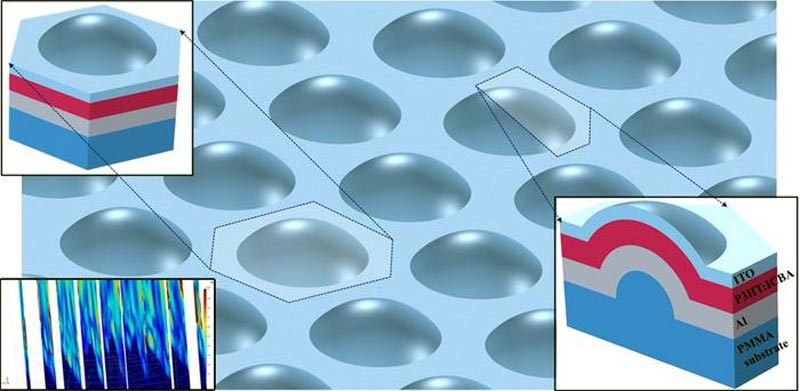
Hemispherical Shells: A New Era for Organic Solar Cells

A hemispherical-shell-shaped organic active layer for photovoltaic application, to improve energy efficiency and angular coverage; (left bottom) spatial distribution of electric field norms.
Credit: D. Hah, doi 10.1117/1.JPE.14.018501
New research proposes to redefine organic solar cells with a hemispherical shell design that offers expanded angular coverage, particularly advantageous for applications requiring flexible light capture, such as wearable electronics.
In the pursuit of sustainable energy solutions, the quest for more efficient solar cells is paramount. Organic photovoltaic cells have emerged as a promising alternative to traditional silicon-based counterparts due to their flexibility and cost-effectiveness. However, optimizing their performance remains a significant challenge.
Embracing a new form
In a pioneering move, new research from Abdullah Gül University (Türkiye) reimagines the structure of organic photovoltaic cells, opting for a hemispherical shell shape to unlock unprecedented potential in light absorption and angular coverage. As reported in the SPIE Journal of Photonics for Energy (JPE), this innovative configuration aims to maximize light absorption and angular coverage, promising to redefine the landscape of renewable energy technologies. The study presents advanced computational analysis and comparative benchmarks to spotlight the remarkable capabilities of this new design.
In the study, Professor Dooyoung Hah of Abdullah Gül University probes the absorption spectra within the hemispherical-shell-shaped active layer, providing a detailed examination of how light interacts with the cell’s structure and materials through a computational technique known as three-dimensional finite element analysis (FEA). FEA can help solve complex engineering problems by dividing structures into smaller, more manageable parts called finite elements, which allows simulation and analysis of the entire structure’s behavior under various conditions, such as different light wavelengths and angles of incidence.
The FEA results reported are remarkable. When subjected to transverse electric (TE)-polarized light, the hemispherical shell structure exhibited a remarkable 66 percent increase in light absorption compared to flat-structured devices. Similarly, for transverse magnetic (TM)-polarized light, a notable 36 percent improvement was observed.
In contrast to previously reported semicylindrical shell designs, the hemispherical shell structure emerged as a clear frontrunner. It boasted a significant 13 percent increase in light absorption for TE polarization and an impressive 21 percent improvement for TM polarization.
Radiant future: Illuminating diverse applications
Beyond its exceptional absorption capabilities, the hemispherical shell structure offers expanded angular coverage, spanning up to 81 degrees for TE polarization and 82 degrees for TM polarization. This adaptability is particularly advantageous for applications requiring flexible light capture, such as wearable electronics.
Hah remarks, “With the improved absorption and omnidirectionality characteristics, the proposed hemispherical-shell-shaped active layers will be found beneficial in various application areas of organic solar cells, such as biomedical devices, as well as applications such as power-generation windows and greenhouses, internet-of-things, and so on.”
The hemispherical shell shape marks a significant leap forward in organic solar cell design. By harnessing the power of finite element analysis and innovative structural engineering, the reported research helps light the way for a brighter, more sustainable future powered by renewable energy.
For details, read the original article by D. Hah, “Hemispherical-shell-shaped organic photovoltaic cells for absorption enhancement and improved angular coverage,” J. Photon. Energy 14(1), 018501 (2024) doi 10.1117/1.JPE.14.018501.
Journal: Journal of Photonics for Energy
DOI: 10.1117/1.JPE.14.018501
Article Title: Hemispherical-shell-shaped organic photovoltaic cells for absorption enhancement and improved angular coverage
Article Publication Date: 14-Feb-2024
Media Contact
Daneet Steffens
SPIE–International Society for Optics and Photonics
daneets@spie.org
Office: 360-685-5478
Original Source
https://spie.org/news/harnessing-light-with-hemispherical-shells









![[Figure 1] Schematic of next-generation CNT-PANI composite fiber supercapacitor and comparison graph with recent results](https://www.innovations-report.com/wp-content/uploads/2025/05/KIST_leads_next-generation_energy_storage_technolo_1746783279-e1746784635527-362x245.jpg)


